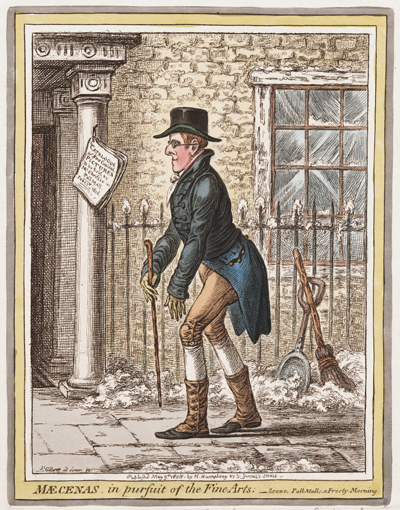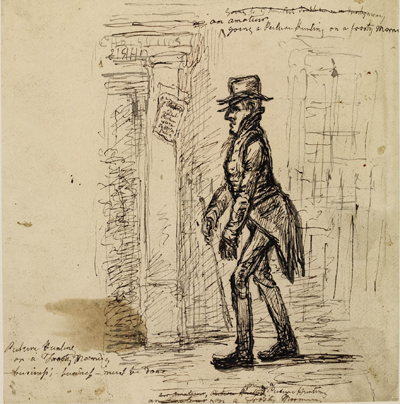Maecenas in Pursuit of the Fine Arts
Maecenas in Pursuit of the Fine Arts is a wonderfully detailed portrait caricature showing the Marquis of Stafford walking up to Christie's Auction House at its location in Pall Mall. Like portrait caricatures going back all the way to the Darly macaroni prints of the 1770s, the Marquis is seen in profile, his identity suggested by the title, but nowhere stated.

© Lewis Walpole Library, Yale University
The enormously wealthy Roman, Gaius Maecenas, was a close friend and diplomatic representative of the Roman Emperor Caesar Augustus. But by Gillray's time, Maecenas had become best known not for his diplomatic skills but for using his wealth and patronage to support Virgil and Horace, two of the greatest Roman poets. That distinction served to make his name synonymous with a patron of the arts.
Gillray's application of the name to the Marquis of Stafford is perfectly apt. According to the Dictionary of National Biography, by 1808 when Gillray's print appeared, the combination of wealth inherited from his own relations and the wealth acquired through his marriage with Elizabeth, Countess of Sutherland, made the Marquis the richest man in England. Always of somewhat delicate health and studious disposition, he increasingly used that wealth in support of British art.
According to the Monthly Magazine in January 1808, Benjamin West, the President of the Royal Academy, specifically singled out the Marquis of Stafford at an entertainment given by the Students of the British Gallery, noting that
his unbounded liberality in the purchase of the productions of British artists, and his condescension in having opened his magnificent gallery for their improvement, has contributed more than any other man towards the improvement of the modern school of British Painters.
The publication of Gillray's print on May 9th was most likely prompted by the opening of the Stafford gallery at Cleveland House and the guidebook to the collection written by John Britton to coincide with it announced for "the first week of May."
So why in a May print would Gillray have featured the Marquis bundled up on a frosty morning? From the study for this print in the British Museum, we can see that Gillray had always conceived of the scene as a wintry one.

© Trustees on the British Museum
One explanation is suggested by one of the alternative titles jotted down as part of the drawing in the lower left: "Picture Hunting on Frosty Morning—business; business must be done." The frosty morning emphasizes the dedication of this Maecenas, who braves the cold for art. And indeed the catalog hanging from the pillar indicates that this is the first of February—as cold a month in London as you will find.
But it is also possible that in the loving care dedicated to this print with its broom and shovel and bits of snow clinging to the railing is a memory of a cold trek on a frosty morning that Gillray may have undertaken himself. For in January and February of 1808 notices began appearing of an upcoming sale at Christies of "Original Drawings and Pictures of [John Hamilton] Mortimer. . .[including] all the remaining works of that distinguished Artist... which have been preserved by the family ever since his decease." Mortimer, of course, was one of the earliest and most important influences on both Gillray and Rowlandson. I can't help but think that seeing that listing, Gillray would have taken the walk to Christie's, and I don't think he would have been stopped by the cold.
Sources and Reading
- Commentary from the British Museum on Maecenas in Pursuit of the Fine Arts
- "Gaius Maecenas," Wikipedia
- "George Leveson-Gower, 1st Duke of Sutherland," Wikipedia
- "Leveson-Gower, George Granville," Dictionary of National Biography: Wikisource
- Thomas Wright and R.H. Evans, Historical and Descriptive Account of the Caricatures of James Gillray #560
Comments & Corrections
NOTE: Comments and/or corrections are always appreciated. To make that easier, I have included a form below that you can use. I promise never to share any of the info provided without your express permission.